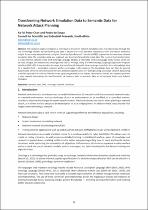 ResearchSpace
ResearchSpace
Transforming network simulation data to semantic data for network attack planning
JavaScript is disabled for your browser. Some features of this site may not work without it.
- ResearchSpace
- →
- Research Publications/Outputs
- →
- Conference Publications
- →
- View Item
| dc.contributor.author |
Chan, Ka Fai P

|
|
| dc.contributor.author |
De Souza, Pedro

|
|
| dc.date.accessioned | 2017-09-20T09:53:56Z | |
| dc.date.available | 2017-09-20T09:53:56Z | |
| dc.date.issued | 2017-03 | |
| dc.identifier.citation | Chan, K.F.P. and De Souza, P. 2017. Transforming network simulation data to semantic data for network attack planning. Proceedings of the 12th International Conference on Cyber Warfare and Security, 2-3 March 2017, Wright State University, Dayton, Ohio, USA | en_US |
| dc.identifier.uri | http://hdl.handle.net/10204/9588 | |
| dc.description | Proceedings of the 12th International Conference on Cyber Warfare and Security, 2-3 March 2017, Wright State University, Dayton, Ohio, USA | en_US |
| dc.description.abstract | This research paper investigates a technique to transform network simulation data into linked data through the use of ontology models. By transforming the data, it allows one to use semantic reasoners to infer and reason additional insight. A case study was performed, using the Common Open Research Emulator (CORE), to generate the necessary network simulation data. The simulation data was analysed, and then transformed into linked data. The result of the transformation is a data file that adheres to the Web Ontology Language (OWL) 2.0 eXtensible Markup Language (XML) format, which can be read, merged, and reasoned by ontology tools such as Protégé. Using the Web Ontology Language Application Program Interface (OWL API), it was possible to merge the transformed data with other ontology models to form a knowledge base for a specific field — particularly network warfare ontologies in this instance. The knowledge base can then be queried dynamically, similar to semantic based intrusion detection systems (IDS). For example using associated network data during a warfare operation in order to infer doctrines, operating procedures or related information. Overall, this research provides a step towards automating the transformation of network data to semantic data to aid network attack and defence strategies. | en_US |
| dc.language.iso | en | en_US |
| dc.relation.ispartofseries | Worklist;19430 | |
| dc.subject | Semantic data | en_US |
| dc.subject | Ontology WeBb Language | en_US |
| dc.subject | OWL | en_US |
| dc.subject | Network simulation | en_US |
| dc.title | Transforming network simulation data to semantic data for network attack planning | en_US |
| dc.type | Conference Presentation | en_US |
| dc.identifier.apacitation | Chan, K. F. P., & De Souza, P. (2017). Transforming network simulation data to semantic data for network attack planning. http://hdl.handle.net/10204/9588 | en_ZA |
| dc.identifier.chicagocitation | Chan, Ke Fai Peter, and Pedro De Souza. "Transforming network simulation data to semantic data for network attack planning." (2017): http://hdl.handle.net/10204/9588 | en_ZA |
| dc.identifier.vancouvercitation | Chan KFP, De Souza P, Transforming network simulation data to semantic data for network attack planning; 2017. http://hdl.handle.net/10204/9588 . | en_ZA |
| dc.identifier.ris | TY - Conference Presentation AU - Chan, Ke Fai Peter AU - De Souza, Pedro AB - This research paper investigates a technique to transform network simulation data into linked data through the use of ontology models. By transforming the data, it allows one to use semantic reasoners to infer and reason additional insight. A case study was performed, using the Common Open Research Emulator (CORE), to generate the necessary network simulation data. The simulation data was analysed, and then transformed into linked data. The result of the transformation is a data file that adheres to the Web Ontology Language (OWL) 2.0 eXtensible Markup Language (XML) format, which can be read, merged, and reasoned by ontology tools such as Protégé. Using the Web Ontology Language Application Program Interface (OWL API), it was possible to merge the transformed data with other ontology models to form a knowledge base for a specific field — particularly network warfare ontologies in this instance. The knowledge base can then be queried dynamically, similar to semantic based intrusion detection systems (IDS). For example using associated network data during a warfare operation in order to infer doctrines, operating procedures or related information. Overall, this research provides a step towards automating the transformation of network data to semantic data to aid network attack and defence strategies. DA - 2017-03 DB - ResearchSpace DP - CSIR KW - Semantic data KW - Ontology WeBb Language KW - OWL KW - Network simulation LK - https://researchspace.csir.co.za PY - 2017 T1 - Transforming network simulation data to semantic data for network attack planning TI - Transforming network simulation data to semantic data for network attack planning UR - http://hdl.handle.net/10204/9588 ER - | en_ZA |





